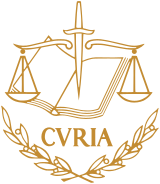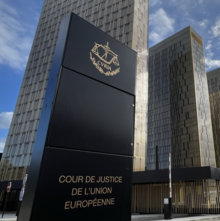The Court of Justice of the European Union (CJEU) (French: Cour de justice de l'Union européenne or "CJUE"; Latin: Curia[2]) is the judicial branch of the European Union (EU). Seated in the Kirchberg quarter of Luxembourg City, Luxembourg, this EU institution consists of two separate courts: the Court of Justice and the General Court.[3][4] From 2005 to 2016, it also contained the Civil Service Tribunal. It has a sui generis court system, meaning 'of its own kind', and is a supranational institution.[5]
 Emblem of the Court of Justice of the European Union | |
 Palais de la Cour de Justice, Luxembourg | |
| Judicial branch overview | |
|---|---|
| Formed | 1952 |
| Jurisdiction | European Union and Northern Ireland[a] |
| Headquarters | Palais de la Cour de Justice, Kirchberg, Luxembourg City, Luxembourg |
| Child agencies | |
The CJEU is the chief judicial authority of the EU and oversees the uniform application and interpretation of European Union law, in co-operation with the national judiciary of the member states.[4] The CJEU also resolves legal disputes between national governments and EU institutions, and may take action against EU institutions on behalf of individuals, companies or organisations whose rights have been infringed.[6]
Composition
editThe CJEU consists of two major courts:[7]
- the Court of Justice, informally known as European Court of Justice (ECJ), which hears applications from national courts for preliminary rulings, annulment and appeals. It consists of one judge from each EU member country, as well as 11 advocates general.
- the General Court, which hears applications for annulment from individuals, companies and, less commonly, national governments (focusing on competition law, state aid, trade, agriculture and trade marks). The General Court is composed of 2 judges from each member country (currently 54),[8] though only 49[citation needed] seats are currently filled.
Judges and advocate generals are appointed for a "renewable 6-year term, jointly by national governments".[9]
Function
editThe CJEU's specific mission is to ensure that "the law is observed" "in the interpretation and application" of the Treaties of the European Union. To achieve this, it:
- reviews the legality of actions taken by the EU's institutions;
- enforces compliance by member states with their obligations under the Treaties, and
- interprets European Union law.[4]
The composition and functioning of the courts are regulated by the Rules of Procedure.[10]
History
editThe CJEU was originally established in 1951 as a single court called the Court of Justice of the European Coal and Steel Communities. With the Euratom and the European Economic Community in 1957 its name changed to the Court of Justice of the European Communities (CJEC).[10] In 1988 the Court requested the Commission to create a Court of First Instance and in 2004 it added the Civil Service Tribunal. [10] The Civil Service Tribunal are for issues of public employment.
The Treaty of Lisbon in 2009 renamed the court system to the "Court of Justice of the European Union" and renamed the CJEC to the "Court of Justice".
The working language of the Court of Justice of the European Union is French.[11]
Legal interpretation
editThe Court of Justice of the European Union embraces the substantive equality interpretation of the European Union anti-discrimination law.[12]
See also
editNotes
edit- ^ Under the terms of the Protocol on Ireland/Northern Ireland, concluded as part of the Brexit withdrawal agreement, the CJEU continues to have jurisdiction over the operation of EU law applying to Northern Ireland in relation to customs and the movement of goods, technical regulations, VAT and excise, the Single Electricity Market and State aid, and may hear applications for preliminary rulings made by Northern Irish courts.[1]
References
edit- ^ House of Lords European Union Committee (1 June 2020). 9th Report of Session 2019–21: The Protocol on Ireland/Northern Ireland (Report). House of Lords. p. 65. Archived from the original on 31 January 2021. Retrieved 2 January 2021.
The Protocol will also confer full jurisdiction on the CJEU to oversee the operation of EU law applying to Northern Ireland in relation to customs and the movement of goods, technical regulations, VAT and excise, the Single Electricity Market and State aid; including the jurisdiction to hear applications for preliminary rulings submitted by the courts of Northern Ireland. The UK will have the right to participate in these proceedings as if it were a Member State.
- ^ "Court of Justice of the European Union". curia.europa.eu.
- ^ Article 19 TEU: The Court of Justice of the European Union shall include the Court of Justice, the General Court and specialised court.
- ^ a b c "General Presentation". Curia. Europa. Retrieved 23 October 2015.
- ^ Bordin, Fernando Lusa; Müller, Andreas Th.; Pascual-Vives, Francisco (31 August 2022). The European Union and Customary International Law. Cambridge University Press. p. 50. ISBN 978-1-108-96751-8.
- ^ "Court of Justice of the European Union (CJEU)". Europa. Retrieved 23 October 2015.
- ^ "Court of Justice of the European Union (CJEU)". Europa.eu. 16 June 2016. Retrieved 13 March 2017.
- ^ "Presentation - Court of Justice of the European Union". CURIA. Retrieved 2 September 2024.
- ^ Court of Justice of the European Union (CJEU), Composition
- ^ a b c European Parliament. Directorate General for Parliamentary Research Services. (2016). The role of constitutional courts in multi-level governance: European Union : the Court of Justice of the European Union. LU: Publications Office. doi:10.2861/8. ISBN 9789284602629.
- ^ "Language arrangements at the Court of Justice of the European Union". Curia. Europa. Retrieved 8 September 2018.
- ^ De Vos, Marc (2020). "The European Court of Justice and the march towards substantive equality in European Union anti-discrimination law". International Journal of Discrimination and the Law. 20: 62–87. doi:10.1177/1358229120927947.
Further reading
edit- Beck, Gunnar (2013). The Legal Reasoning of the Court of Justice of the EU. Oxford: Hart Publishing.
- Mikelsone, Gundega (2013). The Binding Force of the Case Law of the Court of Justice of the European Union. ISSN 2029-2058.[1] Archived 26 October 2019 at the Wayback Machine
- Bobek, Michal (2021). "What Are Grand Chambers for?". Cambridge Yearbook of European Legal Studies. 23: 1–19. doi:10.1017/cel.2021.5. ISSN 1528-8870. S2CID 239103282.
External links
edit- Official website
- Access to documents of the Court of Justice of the EU on EUR-Lex
- The archival fonds of the Court of Justice of the European Union is consultable at the Historical Archives of the European Union